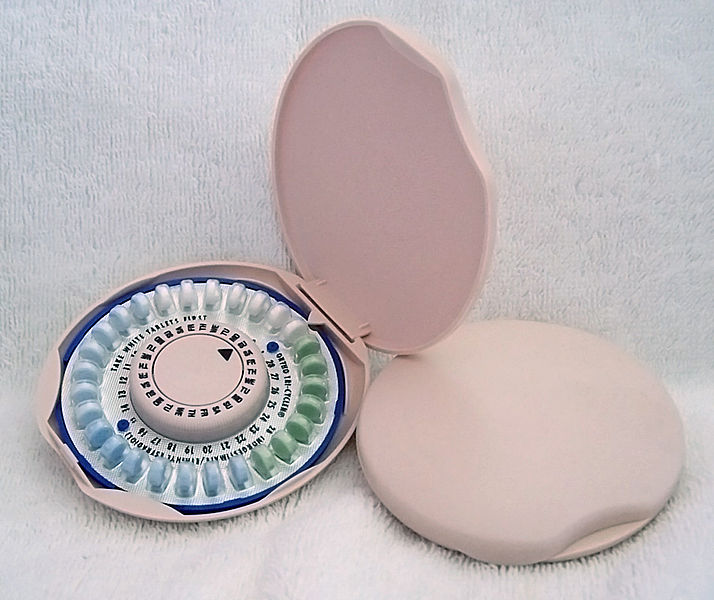Breakthrough bleeding when taking OK is called such bleeding that occurs at the beginning or middle of the menstrual cycle against the background of the use of birth control pills. Unlike scanty spotting blood secretions when getting used to such medications, breakthrough bleeding is very profuse.

Oral contraceptives
Oral contraceptives today are the best option for preventing an unwanted pregnancy. As a rule, when using such funds, a temporary break is assumed during which menstruation should occur. After this period, the woman resumes the use of contraception. However, it often happens that she has breakthrough bleeding when taking OK, that is, profuse spotting that appears outside the prescribed period.
Addictive period
Bleeding with the use of a contraceptive can be considered a very common phenomenon and a negative side effect of this kind of medication. Weak, insignificant bleeding is quite likely during the period of getting used to similar pills.
How long does breakthrough bleeding take with OK? According to statistics, about 40% of women have bloody daubs disappearing in the first months of using oral contraception. At 10%, the adaptation period can last about six months. And in about 5% of women, similar bleeding is noted at the end of the addiction process. Moreover, repeated replacement of these drugs also does not eliminate the negative side effect.

Causes of discharge
However, why does breakthrough bleeding occur when taking OK? The menstrual cycle is a chain of successive changes due to significant updates in the level of sex hormones in the blood. At the first stages of the cycle, estrogen is produced in large volumes. The highest concentration of this hormone is observed during ovulation, and then, if conception has not occurred, it begins to gradually decrease. Along with a decrease in estrogen, an increase in progesterone levels occurs, which is responsible for rejection of the uterine endometrial layer. A similar process manifests itself in the form of menstruation.
In other words, nature made sure that at different phases of the cycle the woman’s body produced certain concentrations of hormones. It should be noted that all modern oral contraceptives include minor dosages of active elements, and their initial concentration may simply not be enough in order to cover the normal level of these compounds. Therefore, an adaptation period is necessary so that the female body gets used to small doses of hormones and does not tear off the endometrial layer before the due date (that is, until the end of taking the tablets from the package).
What is characterized by bleeding when taking oral contraceptives? If, during the use of the new drug, menstruation occurs in small quantities, and for hygiene a woman needs only daily pads, there is no point in taking any measures, since the body often cope with this side effect of the oral drug on its own. Such spotting does not pose any threat to a woman and their presence in the first three months of pregnancy protection does not need to be replaced or canceled by OK. It is also necessary to emphasize that such bleeding does not reduce the contraceptive effect of the drug.

The only thing you should not forget is taking pills at a specific time. It is very important to understand that there are no “bad” or “good” contraceptives, but there are suitable means for a particular woman and not suitable.
Inadequate dosage of hormones
When the addiction process is completed, and small blood loss is noted in the middle or in the initial phase of the cycle, this indicates an insufficient dosage of the estrogen element in the drug, therefore, it is likely that the selection of a drug with a higher content of this hormone will solve this problem. If the adaptation period is over, and bleeding in the middle of the cycle continues to be observed, this may indicate a deficiency of the gestagen component. This means that it is necessary to start using a medication with a higher dosage of gestagen. However, if in this case the discharge does not stop or, on the contrary, intensifies, and they are accompanied by painful sensations in the lower abdomen, it is necessary to consult a gynecologist. So, why does breakthrough bleeding occur when taking OK?
Causes of Breakthrough Bleeding
When a woman during taking a hormonal contraceptive has abundant blood discharge, reminiscent of menstruation, a similar clinical picture, as a rule, indicates a breakthrough uterine bleeding. It develops because in the process of the uterus getting used to the new hormonal status, there is an increase in endometrial atrophy as a result of exposure to progestogens, and the dose of the estrogen component in the contraceptive is very small and does not allow performing hemostatic (hemostatic) functions.
As already noted, during the normal cycle, by the end of menstruation, the level of estrogen in the blood rises, as a result of which the detachment of the endometrial layer stops, and the blood secretions cease. However, during the use of synthetic hormonal agents, these processes do not always occur correctly. In addition, breakthrough uterine bleeding when taking OK can occur due to the following reasons:

- a variety of gynecological pathologies (ovarian dysfunction, endometriosis, polyps, myoma, narrowing of the uterus);
- smoking, which has a pronounced antiestrogenic effect, which means there is a risk of breakthrough bleeding;
- violations of the contraceptive regimen (missed tablets, abrupt cancellation of the medication);
- the use of antibiotics and medications that affect the nervous system;
- due to diarrhea and vomiting (violation of the absorption process of the components of the drug);
- taking natural medicines based on hypericum;
- under the influence of infections transmitted through sexual contact;
- intolerance to hormonal contraceptives.
Breakthrough bleeding action algorithm
If we talk about the natural causes of breakthrough uterine bleeding (withdrawal bleeding, the adaptation period), then in this case it is most reasonable to rush to the gynecologist. First of all, it is necessary to check the patient for pregnancy. The fact is that pregnancy is not excluded even during the use of OK, especially if a woman was prescribed antibiotics in parallel with them, or one day she forgot to use the drug, or she had attacks of diarrhea or vomiting. It is necessary to recall that the uterus can react with bleeding to the processes of egg implantation, therefore, a specialist needs to conduct a laboratory study of the patient’s urine and blood for the presence of hCG hormone. What else to do with breakthrough bleeding?
Double dosage increase
In cases where pregnancy is not confirmed, the specialist, as a rule, advises to double the dosage of the drug taken (1 tablet in the morning and evening). In this mode of taking a contraceptive, it should be taken until the bleeding stops, and then return to the usual regimen for taking the drug: 1 tablet per day. Since the course of such medications should not exceed 24 days, most likely, you will need to purchase another package of the medication.
It is very important to know that for monophasic hormonal contraceptives, the composition of the tablets is absolutely identical, and for combined oral agents, the pills are numbered in the active cell corresponding to the day of use of the drug. However, it should be remembered that if breakthrough bleeding occurs while taking birth control, it is not recommended to stop using the drug, as this will only strengthen it.

When canceling OK
With a sharp cessation of hormonal contraception, breakthrough bleeding always occurs. This is the same menstruation, which, in fact, does not occur in its natural form, that is, bleeding after the end of contraceptive packaging is always breakthrough. Another thing is if a woman abruptly stops taking pills in the middle of the package, for example, after a few days of use. In this case, breakthrough bleeding will start again, even if it ended recently. Thus, a woman’s body responds to the cessation of certain hormones.
Next, we learn how to stop breakthrough bleeding when taking OK?
Drug therapy
With severe uterine bleeding, if a woman intensively loses blood in large volumes, urgent help is needed. In this case, drug therapy is used and the following drugs are prescribed:
- Dicinon
- "Vikasol";
- "Contrikal";
- Fibrinogen
- Tranexam
- "Oxytocin";
- Calcium Chloride
What are the best contraceptive pills?
Oral contraceptives are the most popular treatment for unwanted pregnancy today. They are of two types:
- combined, which contain progesterone and estrogen;
- gestagenic, based on only one synthetic analogue - progesterone.
The composition of any OK includes the same amount of progesterone, which blocks ovulation. The division of medicines into categories occurs depending on the amount of estrogen in them:
- microdosed;
- low dosage
- high dosage.

But you should not think that the higher the dose of estrogen, the more effective the remedy. Contraceptives are selected individually, taking into account the woman's age, the state of her hormonal background, lifestyle, and the presence of childbirth. But what kind of birth control pills are better to choose, the doctor will tell.
Microdosed, low dosed, high dosed
Microdosage funds are prescribed for non-giving birth girls and adolescents with cycle disorders. The constant dosage of ethinyl estradiol in these preparations is about 20 micrograms, and progestin - from 70 to 150 micrograms. Such contraceptives are: “Logest”, “Novinet”, “Jess Plus”, “Lindinet-20”, “Mercilon”.
Those women who have bloody discharge on a microdose, as well as women who have had childbirth in the past, are recommended tablets with low doses of estrogen, namely: “Diane-35”, “Yarina”, “Janine”, “Marvelon”, “Silhouette "," Regulon "," Tri-Merci "and others. The products in this category contain ethinyl estradiol (30 mcg) and progestins - from 150 to 300 mcg.
High-dose contraceptives are usually prescribed as a therapy for pathologies such as endometriosis, or during treatment of hormonal imbalances. These include: “Ovidon”, “Tri-regol”, “Non-ovlon”, etc. Similar medications are also used as a contraceptive.
Gestagenic drugs
Gestagenic contraceptives include mini-pills that contain only microdoses of the progesterone analogue. This type of contraception is recommended for women during lactation, or for those who do not fit estrogen contraception. Often gestagenic drugs are prescribed to patients with hormonal disorders of the genital area, such as endometriosis, uterine fibroids, adenomyosis.

Mini drank
The following remedies are classified as mini-drank: Charozetta, Norkolut, Microlut, etc. The effectiveness of these drugs is slightly lower than that of combined ones, so when using them you need to follow the instructions and adhere to a certain scheme. Only half of the patients using this type of contraception, ovulation is completely blocked, the rest have a chance of pregnancy.
When choosing a contraceptive, it is imperative to study the hormonal background and, depending on the predominance of any hormones, the gynecologist prescribes two-phase, monophasic or three-phase drugs to the patient, which differ in hormone content and frequency of use, and are also selected taking into account the woman's age and characteristics of her health.
We examined the causes of breakthrough bleeding when taking OK.